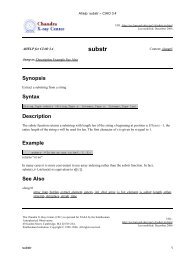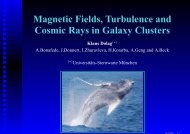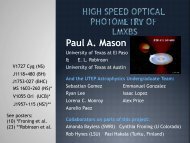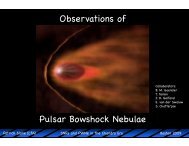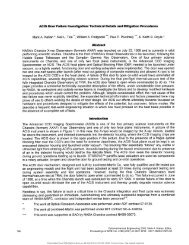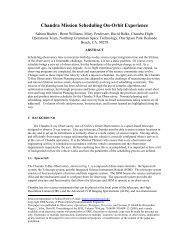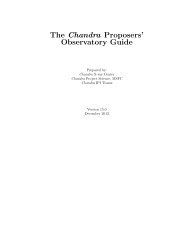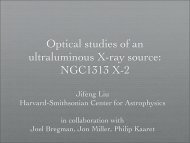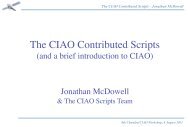PDF Version - Chandra X-Ray Observatory (CXC)
PDF Version - Chandra X-Ray Observatory (CXC)
PDF Version - Chandra X-Ray Observatory (CXC)
You also want an ePaper? Increase the reach of your titles
YUMPU automatically turns print PDFs into web optimized ePapers that Google loves.
24<br />
Oversubscription Ratio<br />
10<br />
9<br />
8<br />
7<br />
6<br />
5<br />
4<br />
3<br />
2<br />
1<br />
0<br />
was discussed with the relevant panel chairs before the recommended<br />
target list was finalized.<br />
The same 3 constraint classes will be retained in Cycle<br />
14 so as to ensure a broad distribution in the requested<br />
contraints. We urge proposers to specify their constraints as<br />
needed by the science.<br />
Cycle 13 observations began<br />
early this year, in July/August, due<br />
to the continuing fall-out from the<br />
spacecraft “MUPS anomaly,” during<br />
the summer of 2009 (described in the<br />
2010 Newsletter) which resulted in<br />
many of the summer Cycle 11 targets<br />
being observed during the summer of<br />
2009. The resulting lack of Cycle 12<br />
summer targets in 2011 meant that<br />
Cycle 13 summer targets were needed<br />
to maintain an efficient schedule. An<br />
announcement was distributed in May<br />
2011 informing Cycle 13 proposers<br />
that they may be called upon for fast<br />
turnaround in checking and confirming<br />
their observation parameters to allow<br />
observation in the summer. Due<br />
to the excellent response of observers<br />
and the diligence of the User Interface<br />
Oversubscription by Category<br />
1 2 3 4 5 6 7 8 9 10 11 12 13<br />
Cycle<br />
GO<br />
LP<br />
VLP<br />
ARCHIVE<br />
THEORY<br />
Fig. 4: The effective over-subscription ratio in terms of observing time for each<br />
proposal type as a function of cycle. Archive and Theory proposal over-subscription<br />
is against available funding. Please note that some of the fluctuations are due<br />
to small number statistics (e.g. Theory proposals).<br />
Early Start for Cycle 13<br />
Observations<br />
NORMAL GALAXIES:<br />
DIFFUSE EMISSION<br />
4%<br />
XVP<br />
<strong>CXC</strong> Newsletter<br />
PIs of proposals with US collaborators<br />
were invited to submit a Cost Pro- posal,<br />
due in Sept 2011 at SAO. In Cycle 13 each<br />
project was allocated a budget based on the<br />
details of the observing program (see CfP<br />
Section 8.4). Awards were made at the allocated<br />
or requested budget levels, whichever<br />
was lower.<br />
Given the early start of observations,<br />
we modified our procedures to facilitate<br />
early award of cost proposals with<br />
observations made in July and August.<br />
Complete proposals submitted before the<br />
7th September deadline and for which observations<br />
had already been made were<br />
treated as high priority, processed and<br />
awarded in mid-October.<br />
The remainder of the award letters were emailed in<br />
late October and November, in good time for the official<br />
start of Cycle 13 on 1 Jan 2012.<br />
Statistics on the results of the peer review can be<br />
found on our website: under “Target Lists and Schedules:”<br />
ACTIVE GALAXIES AND<br />
QUASARS<br />
15%<br />
NORMAL GALAXIES: X-<br />
RAY POPULATIONS<br />
8%<br />
SN, SNR AND ISOLATED<br />
NS<br />
15%<br />
and Mission Planning teams, the updated<br />
procedures ran smoothly and an efficient<br />
schedule was maintained throughout the<br />
summer and beyond.<br />
Time Allocated by Science Category<br />
CLUSTERS OF GALAXIES<br />
17%<br />
BH AND NS BINARIES<br />
12%<br />
Cost Proposals<br />
Proposal Statistics<br />
STARS AND WD<br />
15%<br />
EXTRAGALACTIC<br />
DIFFUSE EMISSION<br />
AND SURVEYS<br />
8%<br />
GALACTIC DIFFUSE<br />
EMISSION AND<br />
SURVEYS<br />
2%<br />
SOLAR SYSTEM<br />
2%<br />
WD BINARIES AND CV<br />
2%<br />
Fig. 5: A pie chart indicating the percentage of <strong>Chandra</strong> time allocated in each science<br />
category. Note that the time available for each category is determined by the demand.



